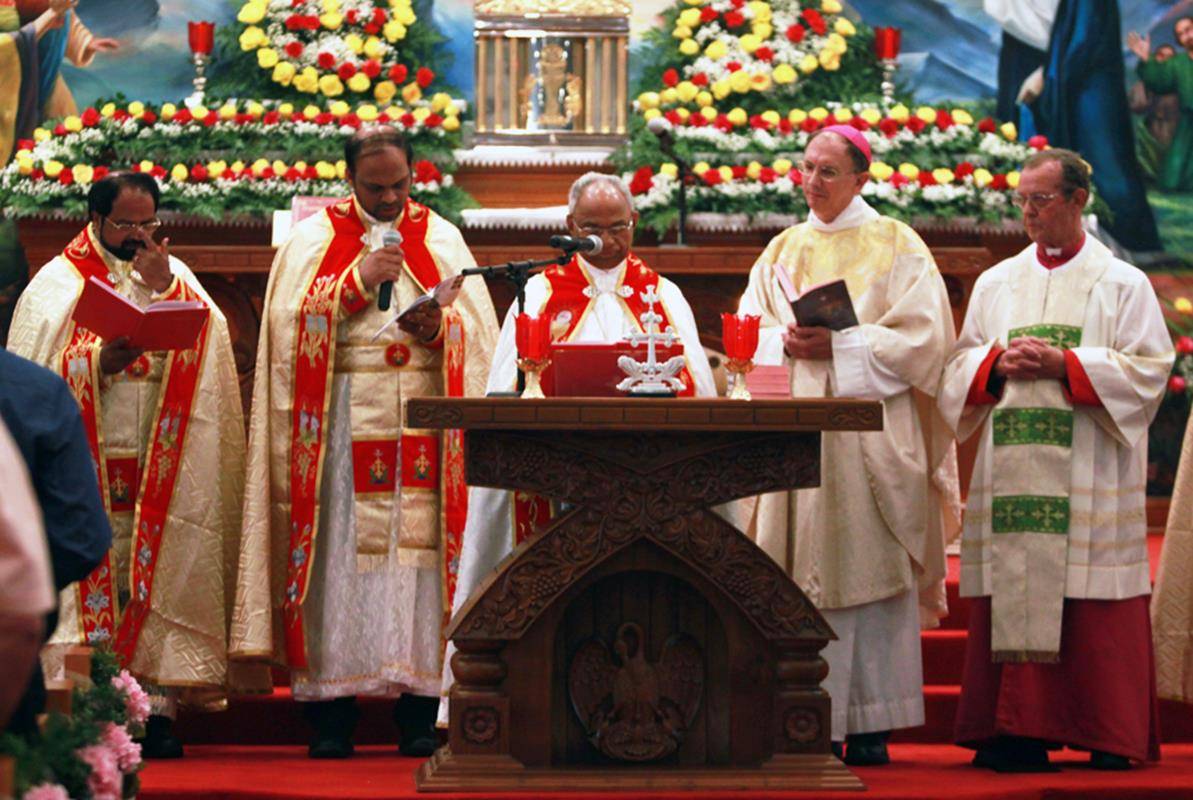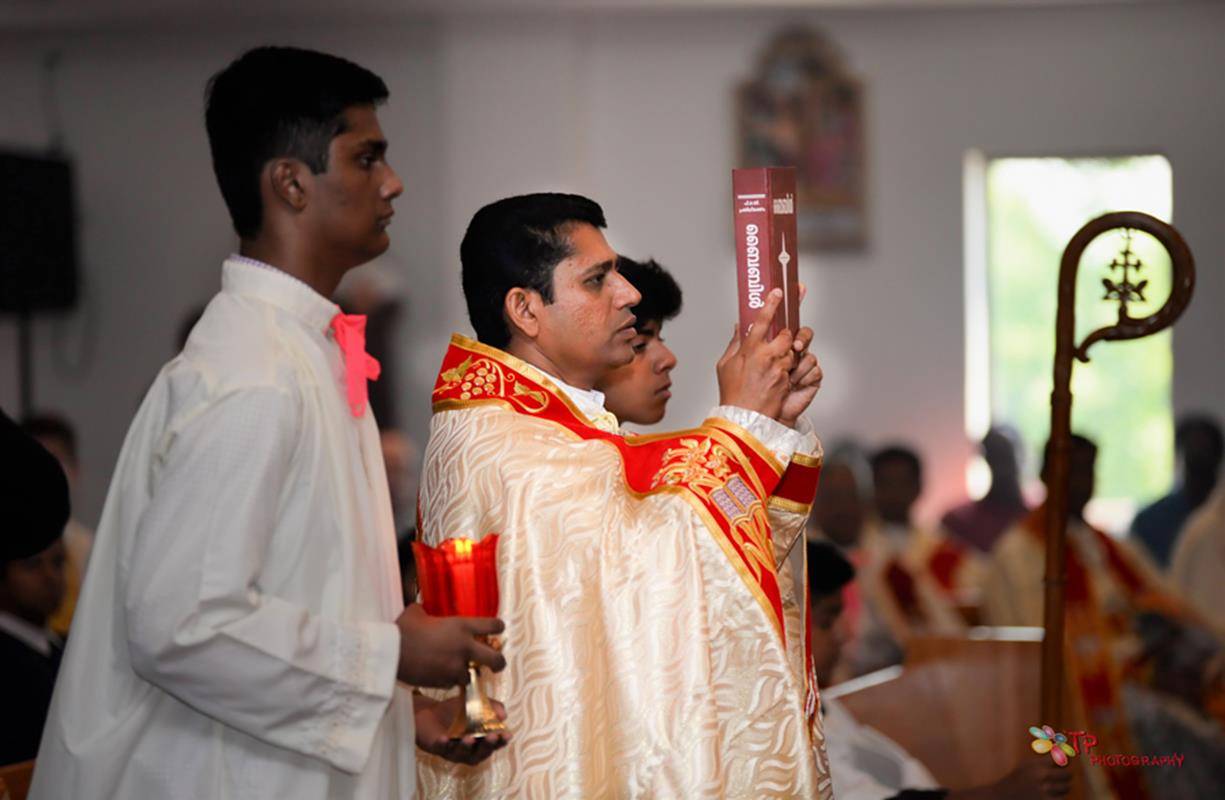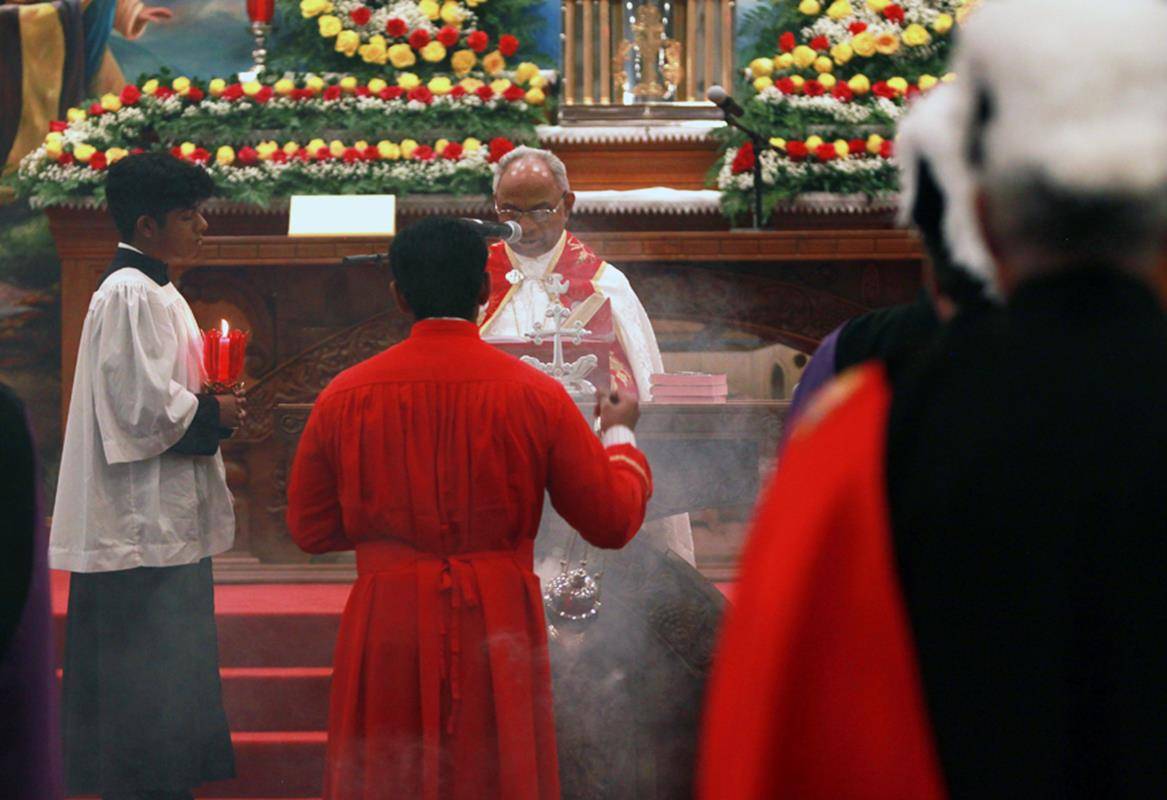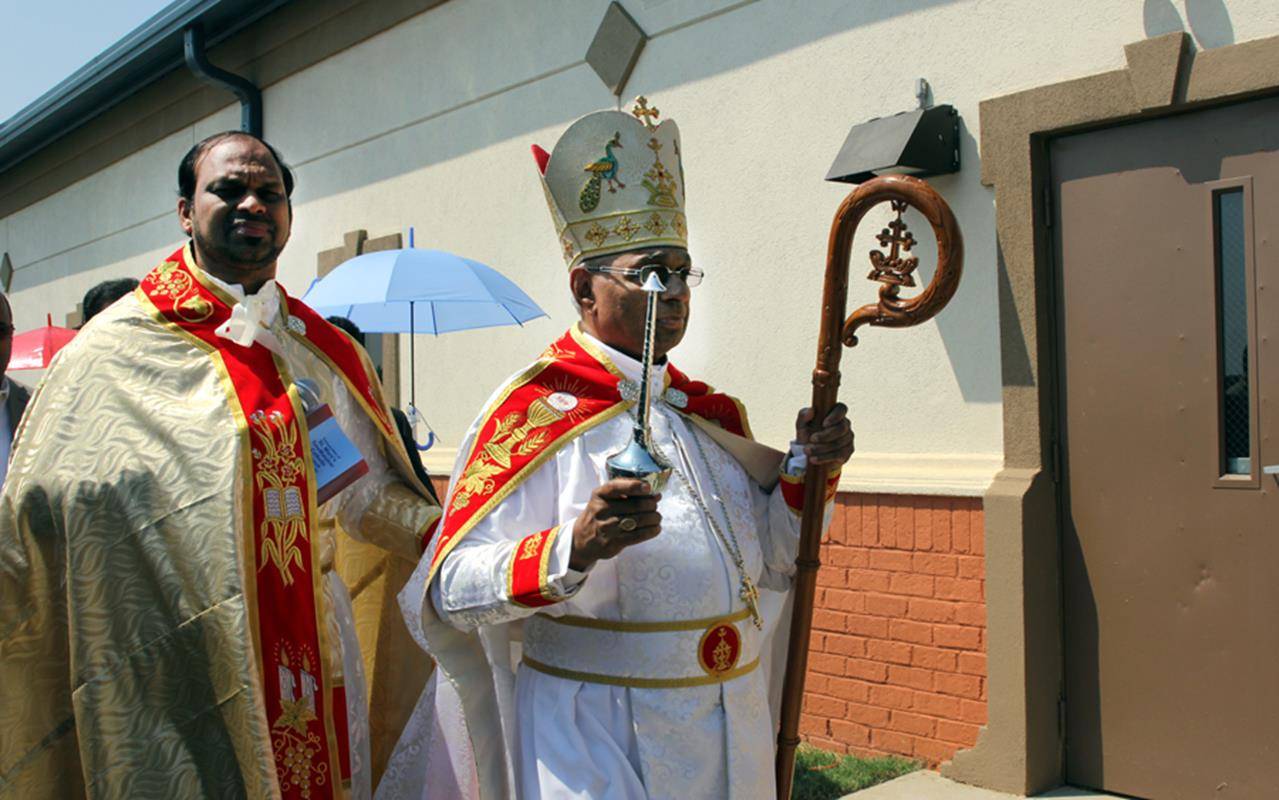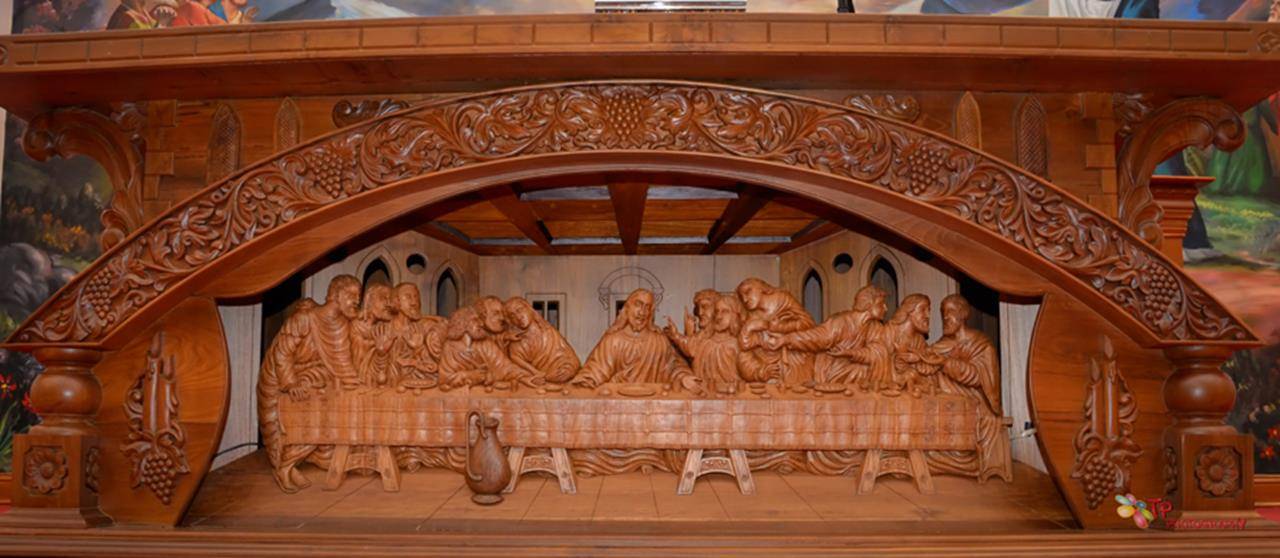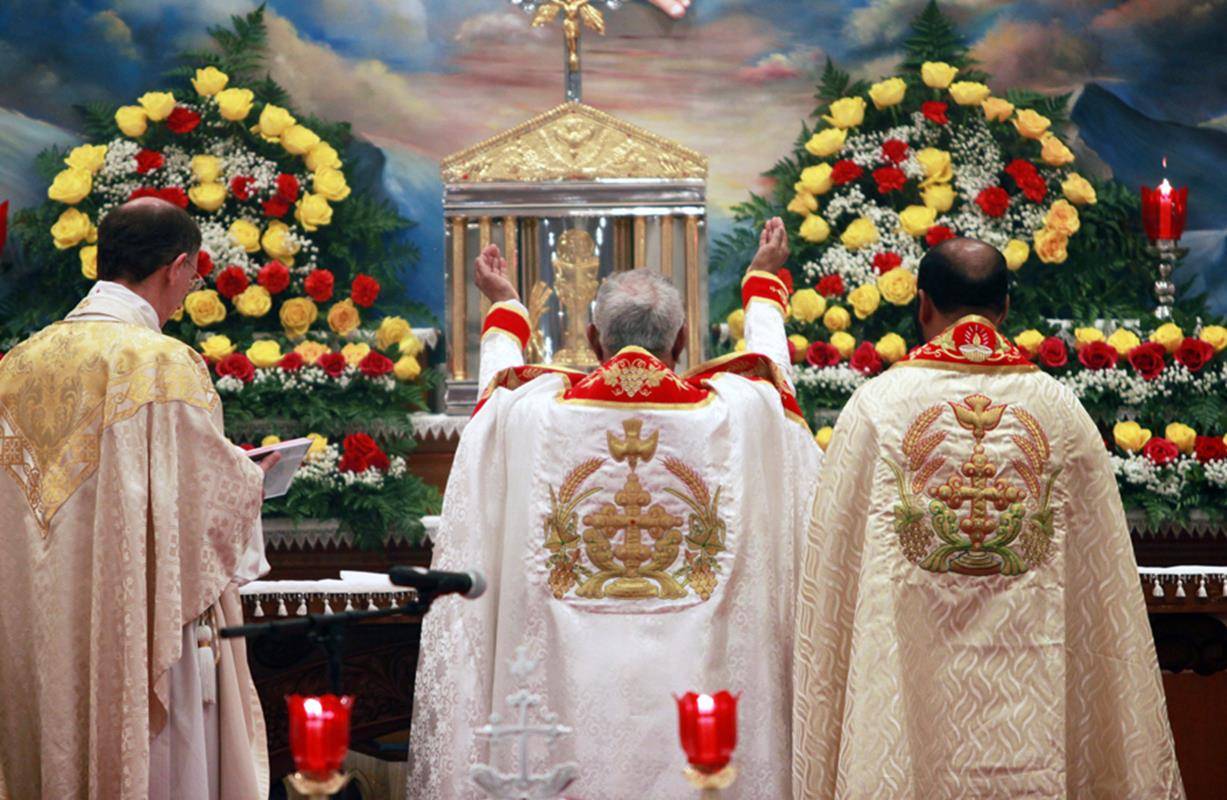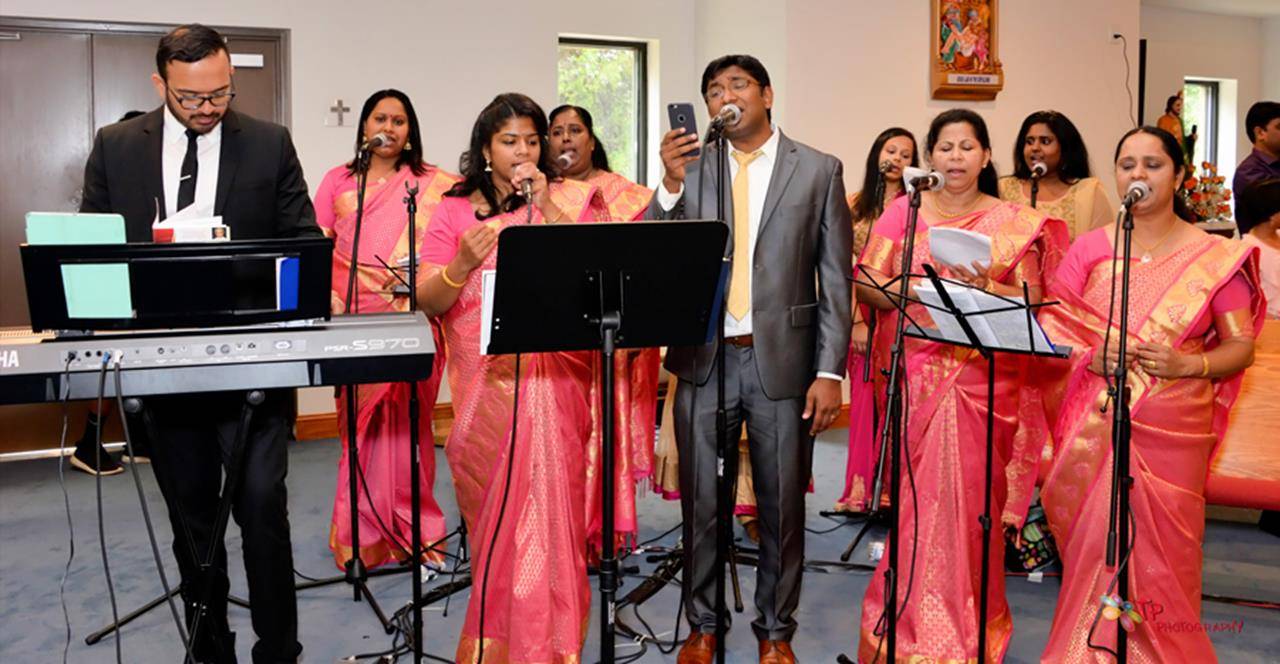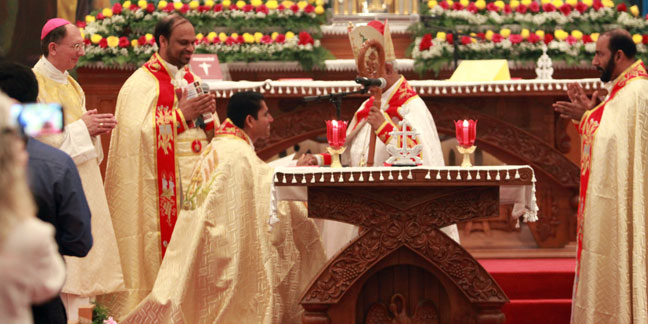 CHARLOTTE — Hundreds of people filled a spacious, brightly-lit building on Arrowood Road July 22 for an occasion years in the making: the consecration of a permanent church for the Indian Catholic community in the Queen City.
CHARLOTTE — Hundreds of people filled a spacious, brightly-lit building on Arrowood Road July 22 for an occasion years in the making: the consecration of a permanent church for the Indian Catholic community in the Queen City.
St. Mary’s Syro-Malabar Catholic Church was dedicated July 22 by Bishop Jacob Angadiath of Chicago during Holy Qurbana, or Mass, celebrated mostly in the Malayalam language.
It is the first permanent home for Charlotte’s Indian Catholic community – comprised of about 45 registered families and growing – and only the second Syro-Malabar Catholic church in North Carolina.
“We have consecrated this church for the public worship of God. It is a gift of God, and let us give thanks to God,” said Bishop Jacob, who shepherds the St. Thomas Syro-Malabar Catholic Eparchy which encompasses all Syro-Malabar Catholics in the U.S.
The four-hour liturgy was concelebrated by Bishop Joy Alappatt, auxiliary bishop of the Chicago eparchy, and Bishop Peter Jugis. Other clergy included Father Paul Chalissery, pastor of St. Mary’s; Father Johnykutty George Puleessery, eparchial chancellor; Father George Maliekal, eparchial finance officer; Father Mathew Elayadathamadam Varkey of Atlanta; Monsignor John McSweeney, retired pastor of St. Matthew Church in Charlotte; Father Pat Hoare, St. Matthew’s new pastor; Father Binoy Davis, St. Matthew’s parochial vicar; and other priests from around the Charlotte diocese.
Bishop Jacob thanked local clergy including Bishop Jugis and Monsignor McSweeney for being a “great source of inspiration and help and support to our community.” He also acknowledged the hard work and sacrifices of the faithful, Father Chalissery and the other Indian priests who minister to the community, and the local Sisters of St. Vincent de Paul and Missionaries of Charity for their prayers and support.
“It’s not an easy task” to build a church, he said, smiling as he expressed gratitude to everyone from the building committee members to the choir. “Every Eucharistic celebration is the greatest thanksgiving. As we celebrate the Holy Qurbana, the Holy Mass, here in the church, we give the greatest thanksgiving to God Almighty for all the blessings we receive every day, and especially the wonderful gift of this particular church. So let us keep in our hearts this gratitude to God Almighty, with all our love, with all our gratitude.”
During the rite of consecration, Bishop Jacob blessed the walls of the church, marked by four small crosses, as well as everyone gathered for the Mass, with holy water and incense. He also anointed the crosses and the altars in the sanctuary with sacred chrism, and lit the flower-adorned Paschal candle.
At the end of Mass, Bishop Jacob officially elevated St. Mary’s from its mission status to that of a parish, and he appointed Father Chalissery as pastor.
Father Chalissery noted, “The Syro-Malabar Catholic community by nature is a missionary community. The consecration is a fulfillment of our dream and our responsibility to hand down the Syro-Malabar Catholic tradition to our next generation and to the people of Charlotte.”
Under the leadership of former pastor Monsignor McSweeney, St. Matthew Church was instrumental in supporting the Indian Catholic community and building the church. Parishioners from the diocese’s largest parish were on hand for the celebration.
“This is the day the Lord has made – let us be glad and rejoice,” said Monsignor McSweeney after Mass, quoting from Psalm 118:24.
He recalled that plans for a Syro-Malabar church named in honor of St. Mary began 30 years ago, then said with a smile, “For the first time in western (North) Carolina today, we’re all part of the establishment of St. Mary Syro-Malabar Parish, and this is truly a day for us to rejoice.”
Two years of planning, led by Father Chalissery and a 16-member building committee, went into the $1.4 million project, which included the land purchase of five acres along Arrowood Road in south Charlotte as well as construction of the church.
The 10,000-square-foot church, which seats approximately 500 people, features a brightly-lit nave (haykla) and spacious sanctuary (madbaha) that contains the altar of sacrifice as well as a little altar and two elaborately carved wooden lecterns.
A striking apse mural frames a statue of Christ ascending to heaven, with the Blessed Virgin Mary and St. Thomas among the witnesses watching Him in amazement. The scene from Acts 1:6-11 was painted by Dr. Ginto Pottackal of Baltimore. The high altar, where the tabernacle is placed, features a carved wood diorama of the Last Supper.
The building also has 10 classrooms and other office facilities.
Bishop Jugis gave the homily at the July 22 Mass, noting that just as the church is consecrated to God, the growing community of Indian Catholic faithful are similarly consecrated – and they must take what they receive in church out into the wider community.
“This new church is a sign of the amazing growth of our Catholic community in this area, and we give thanks to Almighty God for this blessing – this growth of the Catholic faithful – and the many opportunities that the Lord therefore gives us to serve Him as our community grows,” Bishop Jugis said.
Consecrating a church sets it apart from other places, dedicating it exclusively for the worship of God through the offering of the Holy Sacrifice of the Mass, he explained. Through worship and reception of the sacraments, especially the Eucharist, the faithful are “transformed by the power of God’s grace, to grow in holiness.”
That transformation does not end at the church door, he emphasized.
“This church is a center of evangelization. From this place we want Christ’s message to go out to the whole world. We want the love of Christ, which you celebrate here at this altar, to be taken beyond the confines of this physical building – into your homes, your neighborhoods, your workplaces, every place.”
The mission of every Catholic church around the world is to share the Good News of the Gospel, which flows from the Eucharist and transforms and purifies the faithful so that they can bring that Gospel message to others, he said.
Father Chalissery underscored that point, noting that this mission to share the Gospel beyond the church walls will be preeminent at St. Mary’s.
“In 52 A.D. St. Thomas the Apostle baptized our forefathers,” he said. “My vision is to impart the Christ experience of St. Thomas, our father in faith, to the people of our community, especially our younger generation in their faith journey and to motivate them to be ‘missionary disciples.’”
— Patricia L. Guilfoyle, Editor
Who are Syro-Malabar Catholics?
With about 4.6 million members, the Syro-Malabar Church is the second largest Church among the 23 Eastern Catholic Churches in full communion with the pope. It is one of the two Eastern Catholic Churches from India, the other being the Syro-Malankara Catholic Church.
It was founded by the Apostle Thomas, who sailed to the Malabar Coast (modern-day Indian state of Kerala) in 52 A.D. to evangelize the local Aramaic-speaking Jews. He performed miracles and founded seven Christian communities throughout south India before he was martyred in 72 A.D. in Mylapore, India. He is often referred to by his Syriac name Mar Thoma Sleeha, and he is the patron saint of India.
The early Christian community in India was known as St. Thomas Christians or Nazranis, meaning those who follow the path of Jesus of Nazareth. As it lay outside the boundaries of the Roman Empire and the influence of the Latin (Western) Church, the Syro-Malabar Church remained closely connected to the East Syrian (Chaldean) Church, also founded by St. Thomas in what is present-day Syria and Iraq. While culturally distinct, today their liturgy still reflects the liturgical, theological, spiritual and other ecclesiastical traditions of the Eastern Church. “Syro” refers not to Syrian ethnicity, but to the faith that took root in the lands of Syria and Mesopotamia among peoples who spoke Syriac, a dialect of Aramaic, the language Jesus spoke.
The Church was governed by bishops appointed by the East Syrian patriarch until the 16th century, when Portuguese colonizers and their Jesuit priests, suspicious of Hindu influences and various heresies among the Christian faithful, imposed latinization of the liturgy and church governance for the next 300 years. They burned religious texts, conducted an inquisition that saw at least 57 people burned at the stake, forbade people from speaking Syriac/Aramaic, and persecuted local Hindus and any Christians who associated with them. In protest, some St. Thomas Christian communities left the Catholic Church in 1653 and joined the Orthodox Church. The pope sent Carmelite missionaries from the Society for the Propagation of the Faith to restore unity, and most of the communities returned to the Church. Those who remained faithful to Rome came to be called Syro-Malabar Catholics.
Over the past 100 years, popes have sought to restore and protect Syro-Malabar Catholics’ independence, heritage and unique traditions within the universal Church.
Pope Leo XIII reorganized the Syro-Malabar Church in 1887, suppressing the Portuguese authority over the community and instead, starting in 1896, allowing Syro-Malabar Catholics to have bishops of their own rite and nationality. Popes Pius XI and Pius XII further encouraged the Syro-Malabar Church’s growth, re-establishment of their own governance and restoration of their ancient liturgical traditions. The Syro-Malabar rite in use today was approved by the pope in 1957 and introduced in 1962. The Second Vatican Council later affirmed that the traditions of Eastern Catholic Churches should be maintained. Pope John Paul II continued the rebuilding process in the 1990s, and in 2004 granted full administrative powers to the Syro-Malabar Church, including the authority to elect bishops.
The Syro-Malabar Church today is led by Major Archbishop George Cardinal Alencherry and is comprised of five archeparchies and 26 eparchies (dioceses), including St. Thomas Eparchy of Chicago. Established in 2001, it is the first among the three eparchies of the Syro-Malabar Church outside India, and it has jurisdiction over 87,000 Syro-Malabar Catholics spread across the U.S. The eparchy is led by Mar (Bishop) Jacob Angadiath and assisted by Auxiliary Bishop Joy Alappatt.
St. Mary’s Syro-Malabar Church is one of two in North Carolina, the other being Lourdes Matha Syro-Malabar Church in the Raleigh-Durham area.
The St. Thomas or Persian Cross
Unique among St. Thomas Christians, the St. Thomas Cross or “Mar Thoma Sleeva” was so named by the Portuguese missionaries who found the cross in the St. Thomas Christian churches they encountered. The very ancient symbol does not feature a corpus of Christ, as it generally symbolizes life rather than Christ’s Passion and death.
The four edges of the cross have a floral shape, symbolizing the tree of life. The lotus, with the cross over it, shows that Christianity took root in the land of the Hindus.
Above the cross is depicted a dove, representing the Holy Spirit. The three steps below the cross represent Golgotha, the site of Christ’s crucifixion.
Other facts
St. Thomas Christians are a distinct community, both in terms of culture and religion. Though their liturgy and theology remain that of East-Syrian Christians of Persia, their customs and traditions are basically Indian. It is often quoted: “Nazranis are Indian in culture, Christian in faith and Syrian in liturgy.” The Syro-Malabar liturgy is celebrated in Malayalam, the predominant language in Kerala. At St. Mary’s, the liturgy is also celebrated in English.
The Syro-Malabar Church has its own liturgical year, with nine seasons: Annunciation (Agmanam), Epiphany (Denha), Great Fast (nombu), Resurrection (uyirppu), Apostles (Sliha), Summer (Qaita), Elijah-Cross (Elia-Sliba), Moses (Muse), and Dedication of the Church (pallikuddasa).
Its liturgy is the Liturgy of Addai and Mari, traditionally attributed to St. Addai (a disciple of St. Thomas) and St. Mari (a disciple of St. Addai). The Anaphora, or Eucharistic Prayer, is one of the oldest in Christianity, dating back to the third century.
Holy Mass is called Holy Qurbana. The word, which means offering or sacrifice, derives from the East Syriac Aramaic term Qurbana. Other terms include sleeva (cross), madbaha (sanctuary), haykla (nave) and mar (bishop).
— www.nasrani.net, www.syromalabarchurch.in, www.wikipedia.org
Holy Qurbana (Mass) schedule
Monday-Thursday: 7 p.m.
Friday: 7-7:30 p.m. Eucharistic Adoration followed by Holy Qurbana at 7:30 p.m.
Saturday: 9 a.m., followed by Novena of Mother Mary
Sunday: 10:30 a.m.




